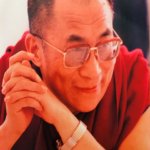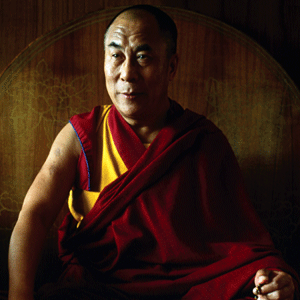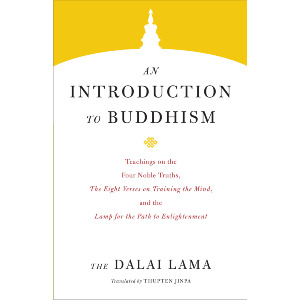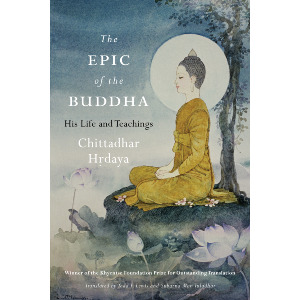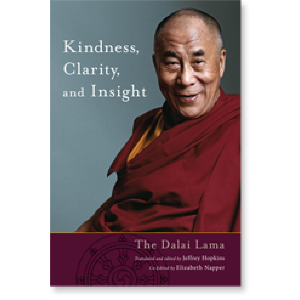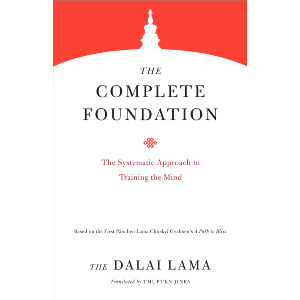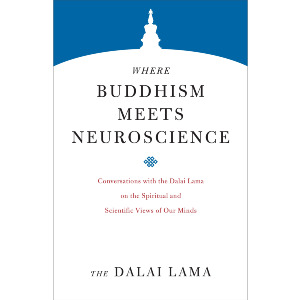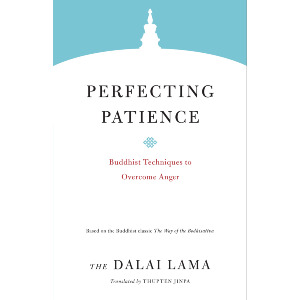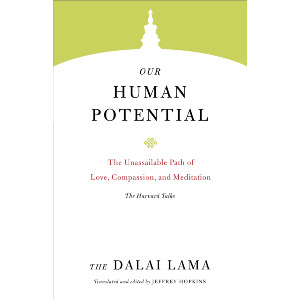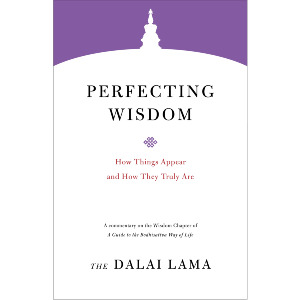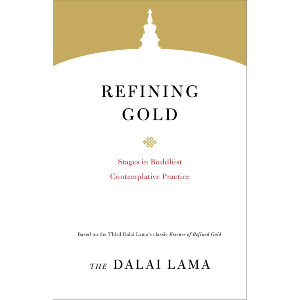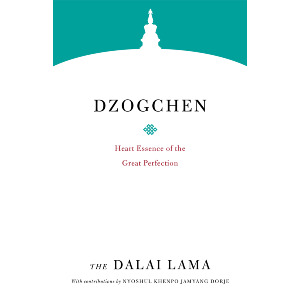| The following article is from the Summer, 1990 issue of the Snow Lion Newsletter and is for historical reference only. You can see this in context of the original newsletter here. |
A Policy of Kindness

Sidney Pibum and other staff of Snow Lion Publications have compiled and edited a wonderful book about the Dalai Lama that is quickly becoming very popular.
Published to honor the winner of the Nobel Peace Prize, it contains a careful selection of addresses, interviews and biographical sketches that present the man and his views on the issues that lead to the award.
Love and kindness are the very basis of society. If we lose these feelings, society will face tremendous difficulties; the survival of humanity will be endangered.
Here are some selections:
Chapter 2: Tibet's Living Buddha, by Pico Iyer
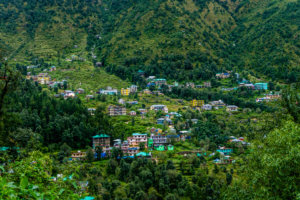
A strong, slightly-stooping figure strides in, bright eyes alertly scanning the crowd, smooth face breaking into a broad and irrepressible smile. Followed by a group of other shaven-headed monks, all of them in claret robes and crested yellow hats, the newcomer clambers up to the temple roof.
There, as the sun begins to rise, his clerics seated before him and the solemn, drawn-out summons of long horns echoing across the valley below, the Dalai Lama leads a private ceremony to welcome the Year of the Earth Dragon.
Tenzin Gyatso, the absolute spiritual and temporal ruler of Tibet, incarnation of the Tibetan god of compassion and fourteenth Dalai Lama in a line that stretches back 597 years...
On the second day of Losar, the Tibetan New Year, the man who is a living Buddha to roughly fourteen million people gives a public audience. By eight A.M. the line of petitioners stretches for half a mile along the winding mountain road outside his airy bungalow-leathery mountain men in gaucho hats, long-haired Westerners, little girls in their prettiest silks, all the six thousand residents of the village and thousands more.
Later, thirty dusty visitors just out of Tibet crowd inside and, as they set eyes on their exiled leader for the first time in almost three decades, fill the small room with racking sobs and sniffles. Through it all, Tenzin Gyatso, the absolute spiritual and temporal ruler of Tibet, incarnation of the Tibetan god of compassion and fourteenth Dalai Lama in a line that stretches back 597 years, remains serene.
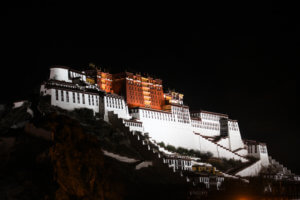
In Tibet, he explains later, Losar used to be conducted on the roof of the thirteen storey Potala Palace, with cookies laid out for the masses.
"Every year I used to be really worried when the people rushed to grab the cookies. First, that the old building would collapse, and second, that someone would fall over the edge. Now,"— the rich baritone breaks into a hearty chuckle,— "now things are much calmer."
Yet even as the "Protector of the Land of Snows" sustains all the secret exoticism of that otherworldly kingdom reimagined in the West as Shangri-La, he remains very much a leader in the real world.
It was twenty-nine years ago last week [1990] that the Tibetan uprising against China's occupying forces propelled the Dalai Lama into Indian exile. Yet the spirit of his ancient, fairy-tale, theocracy is still very much alive in Dharamsala, a former British hill station 250 miles north of New Delhi.
Here, attended by a State Oracle, a rain-making lama, various medicine men, astrologers and a four-man Cabinet, the Dalai Lama, at fifty-two, incarnates all he has done since first ascending the Lion Throne in Lhasa at age four.
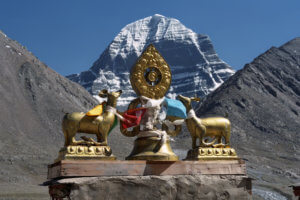
That always inflammatory situation reached a kind of climax last fall, when Tibetans rioted in Lhasa, their Chinese rulers killed as many as thirty-two people. The Dalai Lama held his first major press conference in Dharamsala, and the U.S. Senate unanimously condemned the Chinese actions.
Riots have erupted in recent weeks, but even before that, the modest man in monk's raiment had found himself not only the spiritual symbol linking 100,000 Tibetans in exile to the six million still living under Chinese rule, but also, more than ever, a political rallying point.
"The Fourteenth Dalai Lama may be the most popular Dalai Lama of all," he says smiling merrily. "If the Chinese had treated the Tibetans like real brothers, then the Dalai Lama might not be so popular. So,"— he twinkles impishly—"all the credit goes to the Chinese!"
On paper, then, the Dalai Lama is a living incarnation of a Buddha, the hierarch of a government-in-exile and a doctor of metaphysics. Yet the single most extraordinary thing about him may simply be his sturdy, unassuming humanity.
And even toward those who have killed up to 1.2 million of his people and destroyed 6,254 of his monasteries, the Dalai Lama remains remarkably forbearing.
The Living God is, in his way, as down to earth as the hardy brown oxfords he wears under his monastic robes, and in his eyes is still the mischief of the little boy who used to give his lamas fits with his invincible skills at hide-and-seek.
He delights in tending his flower gardens, looking after wild birds, repairing watches and transistors and, mostly, just meditating. And even toward those who have killed up to 1.2 million of his people and destroyed 6,254 of his monasteries, he remains remarkably forbearing.
"As people who practice the Mahayana Buddhist teaching, we pray every day to develop some kind of unlimited altruism," he says. "So there is no point in developing hatred for the Chinese. Rather, we should develop respect for them and love and compassion."
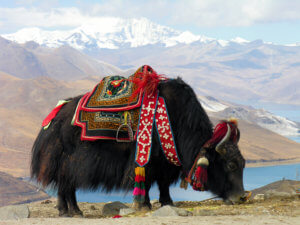
Attribution: Dennis Jarvis; Link to License
The Fourteenth God-King of Tibet was born in a cowshed in the tiny farming village of Takster in 1935. When he was two, a search party of monks, led to his small home by a corpse that seemed to move, a lakeside vision and the appearance of auspicious cloud formations, identified him as the new incarnation of Tibet's patron god.
Two years later, after passing an elaborate battery of tests, the little boy was taken amid a caravan of hundreds into the capital of Lhasa, "Home of the Gods." There he had to live alone with his immediate elder brother in the cavernous thousand-chamber Potala Palace and undertake an eighteen-year course in Metaphysics.
By the age of seven, he was receiving envoys from President Franklin Roosevelt and leading prayers before twenty thousand watchful monks; yet he remained a thoroughly normal little boy who loved to whiz around the holy compound in a pedal car and instigate fights with his siblings.
"I recall one summer day—I must have been about seven—when my mother took me to the Norbulingka Summer Palace to see His Holiness," recalls the Dalai Lama's youngest brother Tenzin Choegyal. "When we got there, His Holiness was watering his plants. The next thing I knew, he was turning the hose on me!"
It was at this time too that the precocious boy first displayed his prodigious gift for things scientific, teaching himself the principles of the combustion engine and fixing the palace's generator whenever it went on the blink. To satisfy his insatiable curiosity about a world he was permitted to glimpse only through the silk-fringed curtains of his golden palanquin, the young ruler set up a projector by which he eagerly devoured Tarzan movies, Henry V and, best of all, home movies of his own capital. Often, he recalls, he would take a telescope onto the palace roof and wistfully gaze at the boys and girls of Lhasa carelessly going about their lives.
In 1950. . . his mountain kingdom was shattered as the Chinese attacked from eight different directions.
In 1950 the isolation of the "Wish-Fulfilling Gem" and his mountain kingdom was shattered as the Chinese attacked from eight different directions. Suddenly the teenage ruler was obliged to take a crash course in statesmanship, traveling to Beijing to negotiate with Zhou Enlai and Mao Zedong.
Finally, in March 1959, when a bloody confrontation seemed imminent as thirty thousand steadfast Tibetans rose up against Chinese rule, the Dalai Lama slipped out of his summer palace dressed as a humble soldier and set off across the highest mountains on earth. Two weeks later, suffering from dysentery and on the back of a dzo, a hybrid yak, the "Holder of the White Lotus" rode into exile in India.
"When we were in Tibet, there were certain ceremonial activities that took up a lot of time, but the substance was—not much. All those exist no longer. That's good, I think. Also, because we are refugees, we have become much more realistic. There's no point now in pretending."
It is, in fact, the peculiar misfortune of the Chinese to be up against one of those rare souls it is all but impossible to dislike.
Many young Tibetans would like their leader to be more militant. Angrily noting that there are more than three thousand political prisoners in central Tibet alone and that Beijing has at least three hundred thousand troops on the "Rooftop of the World," they advocate violence. But the Dalai Lama refuses to be intemperate.
"Once your mind is dominated by anger," he notes thoughtfully, "it becomes almost mad. You cannot take right decisions, and you cannot see reality. But if your mind is calm and stable, you will see everything exactly as it is. I think all politicians need this kind of patience. Compared with the previous Soviet leaders, for example, Gorbachev, I think, is much more calm. Therefore, more effective."
Pacifism, however, does not mean passivity.
"Ultimately," he continues, "the Chinese have to realize that Tibet is a separate country. If Tibet was always truly a part of China, then, whether Tibetans liked it or not, they would have to live with it. But that's not the case. So we have every right to demand our rights."
. . . .Buddhism can show Marxism how to develop a genuine socialist ideal not through force, but through reason, through a very gentle training of the mind, through the development of altruism.
The Dalai Lama spends much of his time reflecting on how Tibetan Buddhism can teach, and learn from, other disciplines. He believes, for example, that Buddhism can show Marxism how to develop a genuine socialist ideal not through force, but through reason, through a very gentle training of the mind, through the development of altruism.
He sees many points of contact between his faith and psychology, cosmology, neurobiology, the social sciences and physics.
"There are many thing we Buddhists should learn from the latest scientific findings. And scientists can learn from Buddhist explanations. We must conduct research, and then accept the results. If they don't stand up to experimentation," he says, beaming subversively, "Buddha's own words must be rejected."
Such quiet radicalism has at times unsettled followers so devout that they would readily give up their lives for their leader. In the draft constitution he drew up in 1963, the God-King included, against his people's wishes, a clause that would allow for his impeachment. Now he is considering new methods for choosing the next Dalai Lama—adopting an electoral system similar to the Vatican's, perhaps, or selecting on the basis of seniority, or even dispensing with the entire institution.
"I think the time has come—not necessarily to take a decision very soon, but to start a more formal discussion, so that people can prepare their minds for it."
It is, in fact, the peculiar misfortune of the Chinese to be up against one of those rare souls it is all but impossible to dislike.
In the meantime, the exiled leader will continue to pursue a simple, selfless life that is close to the Buddhist ideal of the Middle Way neither hostile to the world nor hostage to it. Buddhism's supreme living deity still refuses to fly first class and thinks of himself always, as he told the press last fall, as a simple Buddhist monk. Though he is one of the most erudite scholars of one of the most cerebral of all the world's philosophies, he has a gift for reducing his doctrine to a core of lucid practicality, crystallized in the title of his 1984 book, Kindness, Clarity and Insight (Snow Lion Publications).
"My true religion," he has said, "is kindness."
It is, in fact, the peculiar misfortune of the Chinese to be up against one of those rare souls it is all but impossible to dislike. Beijing has felt it necessary to call him a political corpse, bandit and traitor, a red-handed butcher who subsisted on people's flesh. Yet everyone who meets the Dalai Lama is thoroughly disarmed by his good-natured warmth and by a charisma all the stronger for being so gentle.
To an outsider, the life of a living Buddha can seem a profoundly lonely one. In recent years, moreover, nearly all the people closest to the Tibetan ruler his senior tutor, his junior tutor, his mother and the elder brother who in youth was his only playmate have died. Yet this, like everything else, the Dalai Lama takes, in the deepest sense, philosophically.
"Old friends pass away, new friends appear, he says with cheerful matter-of-factness. It's just like the days. An old day passes, a new day arrives. The important thing is to make it meaningful: a meaningful friend—or a meaningful day."
. . . .Dalai Lama is a living incarnation of a Buddha, the hierarch of a government-in-exile and a doctor of metaphysics. Yet the single most extraordinary thing about him may simply be his sturdy, unassuming humanity.
Chapter 10: Living Sanely
Love and kindness are the very basis of society. If we lose these feelings, society will face tremendous difficulties; the survival of humanity will be endangered.
Question: You often speak about the need for mental peace. What do you mean by it? Does it denote a specific state of mind?
"Mental peace? If you reduce anger and attachment, you reach a point when your mind always remains calm or stable. It is as simple as that. Strong anger and attachment create waves in your mind. People may not realize when they yield to desire or develop attachment that it will cause them mental unrest. But actually, when a strong desire or attachment occurs, during that moment mental peace is lost. To reduce attachment, especially anger or hatred, leads to mental calmness. This is what we call mental peace."—DL
If you reduce anger and attachment, you reach a point when your mind always remains calm or stable.
Question: Isn't it also necessary to practice meditation to obtain mental peace?
"My experience is that it is obtained mainly through reasoning. Meditation does not help much.
"The main cure is to realize how harmful, how negative, anger is. Once you realize very clearly, very convincingly how negative it is, that realization itself has power to reduce anger. You must see that it always brings unhappiness and trouble.
"Of course anger comes. Anger is like a friend or relative which you cannot avoid and always have to associate with. When you get to know him you realize that he is difficult and that you have to be careful. Every time you meet that person still on friendly terms you take some precaution. As a result the influence that he has over you grows less and less. In the same way you see the anger coming, but you realize Ah, it always brings trouble, there is not much point to it. The anger will lose its power or force. So with time it gets weaker and weaker."—DL
The main cure is to realize how harmful, how negative, anger is. Once you realize very clearly, very convincingly how negative it is, that realization itself has power to reduce anger.
Question: To watch your mind, isn't that meditation too?
"If you meditate like that during the meditation period you may find mental peace, or some kind of realization, but that may simply be a diversion from the real problem. The problem is still there. The approach by way of reasoning is not a diversion. You meet anger, negativity and so forth, and because of your mental preparedness the influence of the anger is lessened."—DL
In the human mind both positive and negative thoughts are potentially present. Therefore the only worthwhile thing for a human being to do is to try to develop the positive thought, to increase its power or force and to reduce the negative thinking.
"When you pass through a difficult period, you can react by losing your determination or hope and getting depressed. That of course is very sad, very negative. But the difficult situation can also open your eyes to the real situation, the truth. Look at human history. Human history is in a way the history of human mental thought. Historical events, wars, good developments, tragedies.. .all these are records of negative and positive human thought. All the great persons, the liberators, the great thinkers, all these great human beings of the past, have been produced through positive thought. Tragedy, tyranny, all the terrible wars, all those negative things have happened because of negative human thought.
"In the human mind both positive and negative thoughts are potentially present. Therefore the only worthwhile thing for a human being to do is to try to develop the positive thought, to increase its power or force and to reduce the negative thinking. If you do that, human love, forgiveness, kindness will give you more hope and determination. And hope and determination will bring you a brighter future. If you give way to anger, hatred, you get lost. No sensible human being wants to lose himself or herself.
"This is not a spiritual teaching, not a moral injunction. It is a fact that can be verified by today's experience. So in order to develop human determination you need hope. And to develop hope you need compassion, love. Love and compassion are the basis of hope and determination. So every spiritual teaching of the world emphasizes the importance of love and kindness.
"Now, another point is that human happiness, human satisfaction ultimately must come from within oneself. It is wrong to expect some final satisfaction to come from money or from a computer."—DL
Question: You have seen and experienced the kind of problems that people have in the West. Do you think that the main cause of those problems is neglect of the inner life?
" Yes."—DL
Question: And will the cure to a large extent come through becoming more inwardly aware?
"Yes, there is no doubt about that."—DL
Question: What is the main method to foster this inner awareness?
"Introspection and reasoning is more efficient for this purpose than meditation and prayer."—DL
We can never obtain peace in the world if we neglect the inner world and don't make peace with ourselves.
"We can never obtain peace in the world if we neglect the inner world and don't make peace with ourselves. World peace must develop out of inner peace. Without inner peace it is impossible to achieve world peace, external peace. Weapons themselves do not act. They have not come out of the blue. Man has made them. But even given those weapons, those terrible weapons, they cannot act by themselves. As long as they are left alone in storage, they cannot do any harm. A human being must use them. Someone must push the button. Satan, the evil powers, cannot push that button. Human beings must do it."—DL

